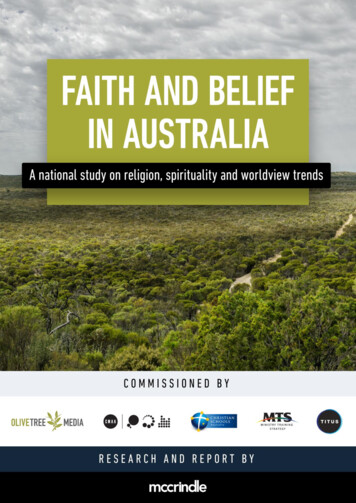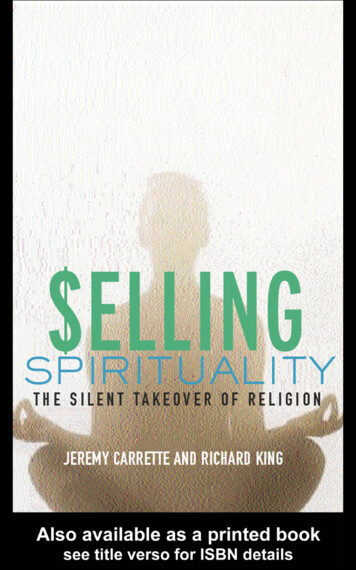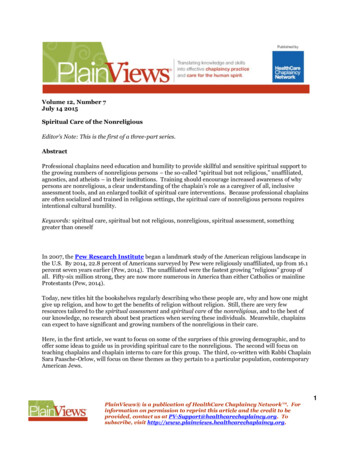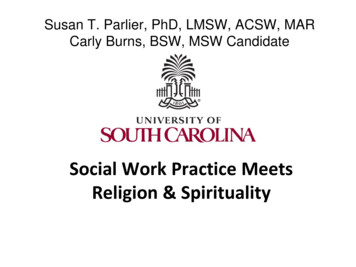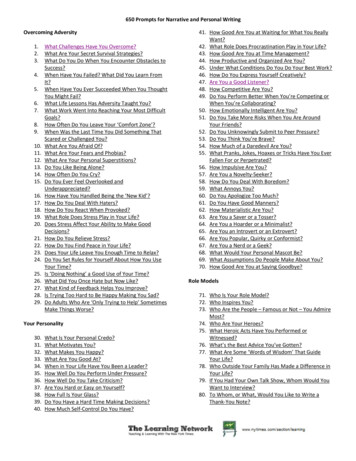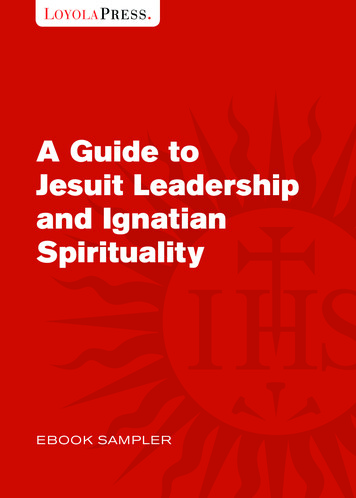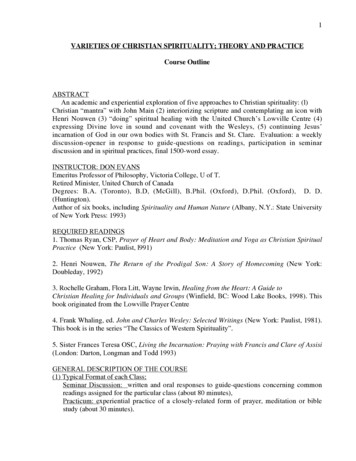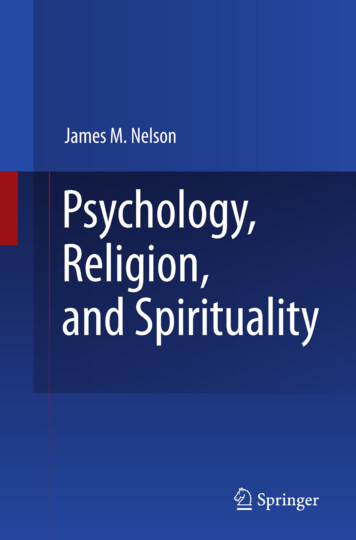
Transcription
Psychology, Religion, and Spirituality
James M. NelsonPsychology, Religion,and Spirituality1 23
AuthorJames M. NelsonDepartment of PsychologyValparaiso UniversityValparaiso, IN 46383USAjim.nelson@valpo.eduISBN 978-0-387-87572-9e-ISBN 978-0-387-87573-6DOI 10.1007/978-0-387-87573-6Library of Congress Control Number: 2008943027 Springer Science Business Media, LLC 2009All rights reserved. This work may not be translated or copied in whole or in part without the writtenpermission of the publisher (Springer Science Business Media, LLC, 233 Spring Street, New York,NY 10013, USA), except for brief excerpts in connection with reviews or scholarly analysis. Usein connection with any form of information storage and retrieval, electronic adaptation, computersoftware, or by similar or dissimilar methodology now known or hereafter developed is forbidden.The use in this publication of trade names, trademarks, service marks, and similar terms, evenif they are not identified as such, is not to be taken as an expression of opinion as to whetheror not they are subject to proprietary rights.Printed on acid-free paper.springer.com
PrefaceOver a century ago, psychologists who were fascinated with religion began to studyand write about it. Theologians and religious practitioners have responded to thisliterature, producing a fascinating dialogue that deals with our fundamental understandings about the human person and our place in the world. This book providesan introduction to the important conversations that have developed out of theseinterchanges.The dialogue between psychology and religion is difficult to study for a numberof reasons. First, it requires knowledge of both psychology and religion. Peoplewith a background in psychology often lack a solid understanding of the religioustraditions they wish to study, and theologians may not be up to date on the latestdevelopments in psychology. Second, it requires conceptual tools to organize thematerial and understand the basic problems involved in any attempt to connect thescience of psychology with religion. These concepts can be found in many places,for instance in the writings of philosophers of science, but they are complex andoften hard to follow for those without a proper theological and philosophical background. Finally, authors who write on the topic come to the study of psychologyand religion from a variety of academic and personal backgrounds. This makes forwonderful diversity in conversations, but it makes understanding and mastery of thematerial quite difficult.Given these problems, why should we try to understand this dialogue? Alongwith many other scholars, I believe that psychology and religion both have thingsto say to each other that are mutually beneficial. Psychology offers religion theresources of science to improve the accuracy of its self-understanding and themethods it uses to pursue desired goals. Religion offers psychology a vast storeof accumulated wisdom on the nature of the human person and how a good lifemight be achieved. As each field hears what the other has to say, there is a responseor critique, and these are of vital importance as well. For instance, theologicalresponses to psychological theory and research provide valuable corrections thatcan help the field avoid mistakes and misunderstandings. Accordingly, this book iswritten from a dialogical perspective, looking at some of the important conversations and critiques that have been exchanged between psychologists, theologiansand religious practitioners. The word “and” in the title of this book reflects thisdialogical aim.v
viPrefaceA dialogical approach to psychology and religion carries with it certain assumptions. First, psychology and religion are treated as equal conversation partners thatare both worthy of respect. Thus, an attempt must be made to avoid privileging eitherfield in our inquiry. Second, while dialogue produces many fascinating connectionsit does not produce a structure that fits both areas into a neat system. While psychology and religion have much to say to each other, they are different in their aims andmethods, so that discontinuities between the fields will always be present.While the book has a primary focus on Christianity––and I write from thatperspective—Hinduism and especially Buddhism have also contributed greatly tothe psychology and religion dialogue. Thus, major sections of the book also discussinformation related to these two traditions. Unfortunately, some other major religions have not been well studied by psychologists, and so there is not a coherentbody of dialogue available for discussion. Thus, there is very little discussion ofJudaism in this book, and only a modest treatment of Islam. Hopefully, theory andresearch will progress in the future so that these important religious traditions willhave a more central place in the conversation with psychology.The Plan of This BookThe fields of psychology, religion, and spirituality have a vast, rich heritage thatis beyond the scope of any single volume or set of volumes. Even the literatureon the intersection between psychology and religion is enormous. Accordingly, ina book such as this, hard choices must be made about what to include and how itshould be discussed. In general, I have tried to provide a bird’s-eye view of the field,indicating important major issues and areas where dialogue is taking place. However, this is a textbook rather than an encyclopedia, so you will not find coverageof all the major writers or research related to psychology, religion and spirituality.Such an undertaking would be neither possible nor desirable in the confines of asingle volume. Instead, it is important to be selective and focus on key figures orideas as a way of introducing various points of view and issues of interest. In orderto understand the current state of the dialogue, it is necessary to focus more onrecent research findings and understandings of various issues, although older workis also considered when it is relevant to current debates. This includes discussionof research in the sociology and anthropology of religion that is of importance topsychology. Each chapter concludes with a discussion of a key issue or theme thatemerges from the psychology and religion dialogue on that topic.The material in the book falls into several sections. Part I deals with fundamentalsin the psychology and religion dialogue. It is very helpful to consider this topic withinthe context of the larger conversation between science and religion. Thus, there isa chapter that introduces the philosophical concepts (e.g., naturalism, materialism)and historical information (e.g., positivist movements) needed to understand the science and religion relationship, particularly as it has worked itself out with referenceto psychology. For those that are unfamiliar with the major religious traditions
Prefaceviiaddressed in the psychology and religion dialogue, a chapter with a brief review ofHinduism, Buddhism and Christianity is also included.Parts II and III cover basic areas in the psychology and religion dialogue as it hasevolved over the past century. Part II also provides an overview of approaches tothe topic that are likely to be central in the future, such as the perspectives providedby neuroscience and postmodernism. Part III summarizes material related to theimportant area of human development, and suggests how new advances in narrativepsychology may help us to understand the process of spiritual growth.Part IV deals with the practical applications of the psychology and religiondialogue. Religion and psychology share a concern with the quality of humanexistence. They hope to offer guidance to people seeking to find meaningful, fulfilled and even happy lives. Thus, a final goal of this book is to harness theory andempirical research in the service of practical applications. How can we in the 21stcentury build positive communities? In what ways can we help individuals dealwith challenges and develop richly satisfying lives? The concluding chapters of thisbook will attempt to begin sketching out answers to these questions.A difficult problem is how to handle terminology and references, which for thistopic must come from a number of fields. For the most part, references utilize thesystem developed by the American Psychological Association, although this is notalways ideal when referring to philosophical or theological works. Multiple authorcitations have been abbreviated somewhat in the text, although the full citation canstill be found in the reference list. A glossary is included at the end of the book thatprovides quick definitions of terms as they are typically used by psychologists,theologians, and religious studies scholars.The primary task of a book such as this is to present ideas that have been influential in the dialogue between psychology and religion. Once we have these ideasin front of us, the next critical task is to evaluate the value of these ideas and theevidence that supports them. This is important, as the ideas of many influentialfigures in the dialogue (e.g. Freud, Fromm) have little or no evidence to supportthem, while other less-known ideas appear on examination to be very attractive.However, evaluation is not easily done. A systematic critique of theories requiresagreement on how they should be evaluated and a body of theoretical discussion orevidence relevant to the task. Unfortunately, one or both of these things is oftenmissing in the science and religion dialogue. Scholars in different fields such associal psychology and religious studies often disagree on what constitutes evidencein support of a position. For instance, scientists often insist upon the presence ofempirical data to support a theory, while a theologian might argue that other kindsof evidence are more relevant and persuasive. There is also much variability in thequantity and quality of critique directed at different positions. Some theories—evengood once—have been the target of extensive critiques, while others have receivedlittle criticism even when there is little data to support them. So while evaluativesections have been included in situations where there has been a lot of scholarlydiscussion about the worth of a particular theory or position, it has not always beenpossible to offer an extensive critique of every theory. Absence of a critique doesnot mean a position is “proven” and presence of a critique does not mean a view has
viiiPrefaceno value. Much remains to be done to evaluate the worth of the many strands in thepsychology and religion dialogue.The Community Behind the Book, with ThanksAny writer is indebted to many people both past and present. One of the most painfulparts of writing the book has been the need to cover rich systems of thought and lifetimes of study by many fine people in a few sentences. Thus, both thanks and apologiesare due to colleagues. Hopefully this book will motivate the reader to pick up and readthe original sources and authors involved in the psychology and religion dialogue.Many of my students have contributed to this book in important ways. John Unrathdid some of the background research for Chapter 12, and Mark Burek contributedsome suggestions on Chapter 13. Kathryn Alfrey, Lisa Daube, Katie Patrick, MarlaTiebert, and Kathy Berg did much of the typing, editing and cross-checking of the reference list, a significant job in a book of this type. Julie Hamaide, Erin Westerman, andJennifer Zimmer read large portions of the text and commented on them from a studentpoint of view, suggesting improvement to make the book more user friendly. They alsoworked with Chrystal Frey and Anthony Nelson in helping to assemble the glossary.Catherine Renken and Megan Berning assisted in the production of the index. Severalof my psychology and religion classes at Valparaiso University and in China have alsoendured earlier versions of the chapters in this book and made helpful suggestions.A number of wonderful colleagues have read and critiqued portions of thisbook. Al Dueck, Ted Ludwig, Nancey Murphy, and Brent Slife have read selectedchapters, while Kevin Mooney and Jeanne Brown read earlier drafts of the entiremanuscript. Richard Gorsuch, Frank Richardson, and Fraser Watts were kindenough to read a final version of the book and offer comments. Throughout thewhole process, the editors at Springer have been tremendously supportive andhelpful, especially Jennifer Hadley and Sharon Panulla. All have made numeroushelpful suggestions that have enriched the final product. Obviously, deficienciesthat remain in the book are my responsibility.Finally, I must acknowledge my faith community and my family, especially mywife Jeanne and children Anthony and Teresa, who warmly supported me during theincessant reading and periodic writing that went into this book.Indiana, USAJames M. Nelson
DisclaimerAlthough this book treats a number of important personal and mental health issues,it is not intended as a volume to provide spiritual or psychological guidance topeople in distress. Individuals struggling with these problems should seek help fromqualified religious and psychological professionals.ix
ContentsPart I1Introduction to Psychology, Religion, and Spirituality.31.11.21.31.41.51.61.72Fundamentals .1Introduction .3Basic Concepts .31.2.1 What is Religion .31.2.2 What Is Spirituality? .8Religion and Spirituality Today .121.3.1 The Secularization Hypothesis .121.3.2 The Religious Transformation Hypothesis .151.3.3 The Cultural Divide Hypothesis .17Psychological Approaches to Religion and Spirituality .171.4.1 What is Psychology?.171.4.2 Early American Psychology of Religion .181.4.3 European Developments .211.4.4 Psychodynamic Approaches .211.4.5 Humanistic and Transpersonal Approaches.231.4.6 Social and Personality Approaches .251.4.7 Integration and Dialogue .27Religious and Theological Responses to Psychology .311.5.1 Paul Tillich.321.5.2 Reinold Niebuhr .341.5.3 Hermeneutic Writers: Don Browning and Paul Ricoeur .36Current Research Approaches .371.6.1 Quantitative Methods.371.6.2 Qualitative Approaches.38Conclusion and a Look Ahead .41Science, Religion, and Psychology .432.1 Philosophical Concepts and Issues in Science and Religion .432.1.1 Empricism.43xi
xiiContents2.22.32.42.52.63Religious Traditions .773.1 Hinduism .773.1.1 Hindu Devotion and Philosophy .783.1.2 Inner Development: Asceticism and yoga .793.2 Buddhism .823.2.1 Early Buddhism and Basic Teachings .833.2.2 Early Meditative Practices .843.2.3 Mahayana Traditions and the Spread of Buddhism .853.2.4 Chan/Zen Buddhism .883.3 Christianity .903.3.1 History and Beliefs .903.3.2 Christian Spirituality .953.4 Conclusion.100Part II42.1.2 Reductionism .442.1.3 Materialism .482.1.4 Naturalism and Scientism .492.1.5 Assessment .51Early Modern Views of Science and Religion .512.2.1 Back ground to the Modern Period .512.2.2 Francis Bacon and the Beginnings of Modern Science .522.2.3 Kant and the Problem of Empiricism and Skepticism.55The Rise of Classical Positivism .572.3.1 Basic Tenants of Classical Positivism .582.3.2 Implications and Assessment .59Logical and Neo-Positivism .602.4.1 Basic Tenants of Logical Positivism.602.4.2 The Destruction of Positivism .632.4.3 Positivism’s Persistence in Psychology and its Effects .65Contemporary Issues in Science and Religion .672.5.1 Developments in 20th Century Physicsand Cosmology . 672.5.2 Understanding Divine Action .692.5.3 Science and Values .702.5.4 Critical Realism .722.5.5 Models for Science and Religion .73Conclusion.74Dialogue—Past, Present, and Future .101Phenomenological Approaches to Religion and Spirituality .1034.1Introduction .1034.1.1 Definitions and Concepts .1034.1.2 Challenges in Studying Religious and SpiritualExperience . 115
Contentsxiii4.2 William James and Varieties of Religious Experience .1174.2.1 Basic Beliefs: Radical Empiricism, Pragmatismand Pure Experience . 1184.2.2 The Varieties of Religious Experience.1194.2.3 Influence and Critique .1214.3 Perennial and Universal Views .1224.3.1 Plotinus .1234.3.2 von Hugel, Pathology, and Religious Experience .1244.3.3 Rudolf Otto .1264.3.4 W. T. Stace .1284.4 Constructivism and Responses .1294.4.1 Sunden and Role Theory .1304.4.2 The Basic Constructivist Position.1304.4.3 Objections to Constructivism .1314.4.4 Moderate Positions .1324.5 Conversion.1334.5.1 Classical Research: Edwin Starbuck .1344.5.2 Types and Motifs of Conversion .1354.6 Religious Perspectives.1364.6.1 Zen Enlightenment and Nontheistic ReligiousExper ience . 1364.6.2 Jonathan Edwards and the Religious Affections .1394.7 Conclusion.1415Psychodynamic and Relational Approaches .1435.1 Sigmund Freud: Master of Suspicion .1435.1.1 Basic Concepts .1445.1.2 Views on Religion .1455.1.3 Impact and Evaluation .1465.2 Carl Jung and Archetypal Religion .1485.2.1 Basic Ideas .1485.2.2 Jung on Christianity .1535.2.3 Jung on Yoga .1545.2.4 Jung on Zen .1555.2.5 Jung’s Ambivalence About the East .1565.2.6 Continuing Conversations .1565.2.7 Critique .1585.3 Erik Erikson .1595.3.1 Basic Concepts .1595.3.2 Application to Religion.1615.3.3 Assessment .1645.4 Object Relations Approaches to Psychology and Religion .1655.4.1 Basic Concepts .1655.4.2 Harry Guntrip .166
xivContents5.4.3 David Winnicott .1695.4.4 Assessment .1715.5 Conclusion.1736Contemporary Approaches and Debates .1756.1 Neurobiological Approaches to Religion .1756.1.1 A Brief Introduction to the Brain.1766.1.2 Evidence for Biological Factors in Religion .1786.1.3 The Mystical Mind .1816.1.4 Evaluation and Critique .1826.2 Evolutionary Psychology and Religion .1836.2.1 Basics of Evolutionary Theory .1846.2.2 Evolutionary Theory in Psychology .1876.2.3 Evolutionary Psychology of Religion.1916.2.4 Positives, Problems, and Prospects.1956.3 Postmodern Perspectives, Psychology, and Religion .1976.3.1 Modernism and Postmodern Critique .1976.3.2 Hermeneutics and the Postmodern Approach toKnowledge . 2006.3.3 Narrative Aspects of Knowledge and Self .2026.3.4 The Human Person as Actor .2046.3.5 Evaluation and Critique .2076.4 Conclusion.208Part III7Human Development .209Fundamentals of Human Development, Religion,and Spirituality . 2117.1 Basic Issues in Developmental Theory .2117.1.1 The Nature of the Change Process and Time .2117.1.2 The Nature and Goal of Development .2137.2 Religious Models of Spiritual Development .2147.2.1 Christian Perspectives.2147.2.2 Concepts of Development in Hinduism and Buddhism .2177.3 Early Genetic Theories of Religious Development .2187.3.1 G. Stanley Hall .2197.3.2 James Mark Baldwin .2197.4 Cognitive-Structuralist Theories of Development.2227.4.1 Jean Piaget .2227.4.2 Lawrence Kohlberg.2277.4.3 James Fowler and Faith Development .2317.4.4 Fritz Oser and Religious Judgment .2357.5 Integrative Approaches to Religious Development .2387.5.1 Ken Wilber .2387.5.2 James Loder .2417.6 Conclusion.243
Contentsxv8Religion and Development in Childhood and Adolescence .2458.1 Religion and Religious Socialization in Childhood .2468.2 Attachment and Religion in Children and Adults .2498.2.1 Attachment Styles .2498.2.2 Attachment and Religion .2518.2.3 Critique .2528.3 God Image and Representation .2538.3.1 Early Psychoanalytic Work.2538.3.2 Gender of God Images.2548.3.3 Development of the God Image.2558.3.4 Dimensions of the God Image .2588.3.5 Impact of the God Image .2598.3.6 Limitations .2598.4 Adolescent Description .2608.5 Identity Development, Gender, and Religion .2638.5.1 Old and New Conceptions of Identity Development .2638.5.2 Religion and Identity Development .2658.5.3 Prosocial Effects of Religion in Adolescence.2668.5.4 Gender, Identity, and Religion .2688.6 Conclusion.2719Religion, Spirituality, and Development in Adulthood .2739.1 Issues in Adult Development Research .2739.2 Young Adult and Midlife Development.2769.2.1 Life Span Patterns.2769.2.2 Emerging Adulthood and Religious Switching .2789.2.3 Midlife and Turning Points .2809.2.4 Belief and Unbelief.2829.3 Mechanisms of Stability and Change .2879.3.1 Stability and Religious Motivation: Internal, External,and Quest . 2879.3.2 Cognitive Perspectives on Change and Development .2919.3.3 Narrative Perspectives on Stability and Change .2949.4 Religion and Spirituality in Older Adulthood .3019.4.1 End of Life Issues .3039.4.2 Religious Perspectives on Older Adulthood and Aging .3049.5 Conclusion.307Part IV Applications.30910Religion, Spirituality, and Physical Health .31110.1 Scientific Approaches to Religion and Health .31110.1.1 Definitions of Health .31110.1.2 Effects of Religion on Health and Illness .31310.1.3 Critique .
psychology may help us to understand the process of spiritual growth. Part IV deals with the practical applications of the psychology and religion dialogue. Religion and psychology share a concern with the quality of human existence. They hope to offer guidance to people seeking to find meaningful, ful-filled and even happy lives.
